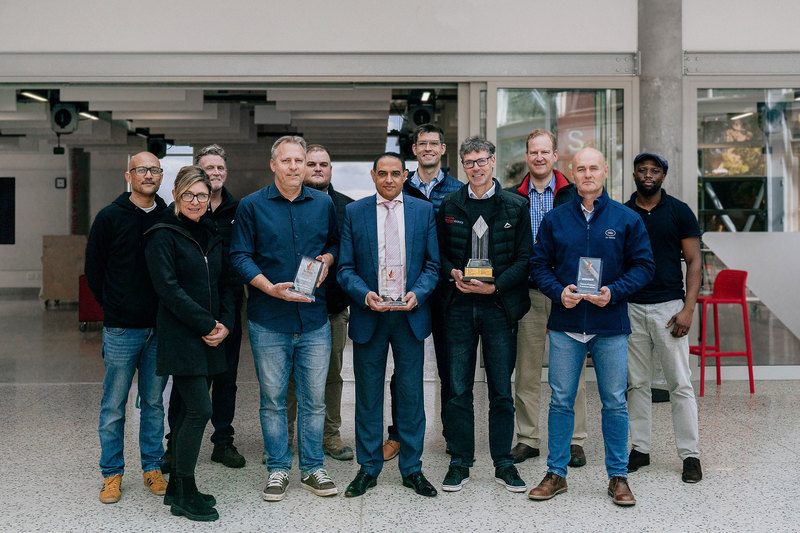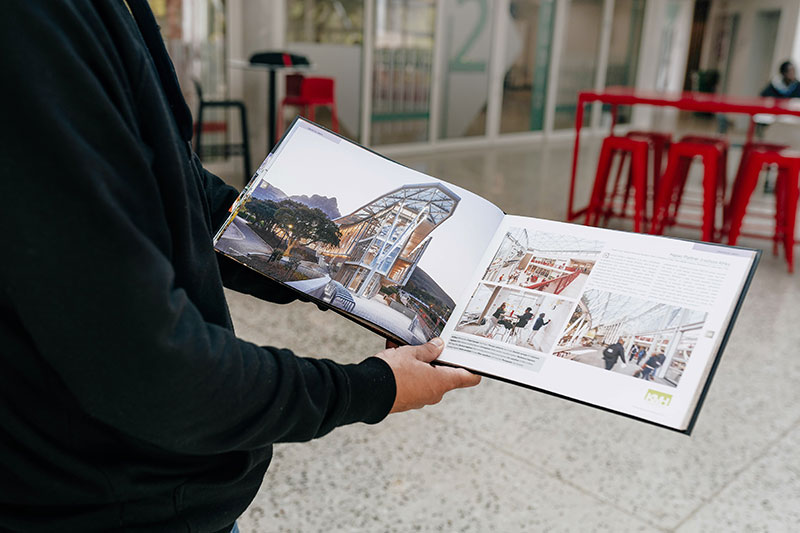More accolades for UCT’s d-school
03 October 2023 | Story Helen Swingler. Read time >10 min.
It has been a season of accolades for the Hasso Plattner School of Design Thinking Afrika (d-school Afrika) building at the University of Cape Town (UCT). Besides a recent South African Institution of Civil Engineering award, the building also achieved a 6 Star Green Star Design rating from the Green Building Council South Africa (GBCSA). It was also named overall winner at the South African Property Association’s (SAPOA) annual awards and collected further SAPOA awards for sustainability and innovation.
The 6 Star Green Star Design rating is a first for an academic building on the continent. It is the highest rating a building can achieve within the Green Star standard and recognises world leadership in environmental sustainability.
The Green Star rating tool provides an objective measurement for green buildings in South Africa and Africa and recognises and rewards environmental leadership in the property industry. The rating encourages and supports design professionals and developers working to create more environmentally sustainable buildings – for people and planet.
The SAPOA awards recognise elements such as design, functionality, environmental sustainability, facilities and user satisfaction, social impact, and economic and financial considerations.
Celebrating these achievements, UCT’s acting chief operating officer, Mughtar Parker, said, “The d-school Afrika was a well-planned and executed donor-funded project, notwithstanding the fact that this project was primarily designed and built during the COVID-19 pandemic.”
He added, “As one of three d-schools in the world, the others being at Standford and Potsdam, we are certainly in good company.”

“Personally, receiving the award filled me with immense pride and ensured UCT is certainly now a leader in the property ownership and development industry – and not only seen as the leading academic institution in South Africa,” Parker continued. “As one of the largest property owners in the Western Cape, this recognition enables UCT to go on and do far greater things as part of its social investment and urban regeneration initiatives. Strategically, this aligns with the UCT Integrated Development Framework and Urban Design Framework, and through continued support from donors, we certainly will entrench UCT being the top university in Africa – academically, technologically and infrastructurally –and attain our Vision 2030 objectives.
UCT’s green building policy
With the d-school Afrika’s 6-star-rated building, UCT now has five buildings certified by the GBCSA, including these 4-star facilities: the New Lecture Theatre on upper campus; the Graduate School of Business Conference Centre at the Breakwater campus; Avenue Road Residence on lower campus; and the Neville Alexander School of Education on middle campus.
The d-school Afrika and the other Green-Star-rated buildings are a response to UCT’s policy on green buildings, which has been a requirement since 2012 for every new building on campus to be at least a 4-star-rated building. This policy has recently been updated with more detail and to expand this to all new buildings and refurbishments above R20 million, including some specific targets for energy and water.
UCT’s Minimum Green Building Construction Standard policy was approved by the university’s Council in their June 2023 meeting. It directly supports UCT’s Vision 2030, where sustainability is a key pillar, as well as supporting UCT’s Environmental Sustainability Strategy, which includes the goal of the campus becoming a net-zero energy/carbon, water and waste-to-landfill campus by 2050 or sooner.
Sustainability a core value
Importantly, the 6 Star Green Star award underscores the importance of sustainability, one of the three pillars of UCT’s Vision 2030, along with transformation and excellence. So, too, is it an underpinning value for the building’s funders, the Hasso Plattner Foundation (HPF), said executive director, Dr Stephanie Ullrich.
In her congratulation, Dr Ullrich said, “[The award] embodies the d-school Afrika’s aspiration of being a hub for bright ideas that shape a better future. Sustainability is one of our foundation’s core values, emphasising long-term solutions and resource-consciousness.”
She added, “The d-school Afrika building vividly exemplifies this ethos and we eagerly anticipate the innovative ideas about to be sparked in its halls.”
Design-led thinking is an approach and mindset that drives change and innovation.”
Richard Perez, the director of the d-school Afrika, described the 6-star rating as “a great milestone achievement”.
“It honours our philosophy as a d-school. It was important when we were conceptualising our place that it spoke to who we are and what our purpose is. Design-led thinking is an approach and mindset that drives change and innovation.”
He added: “In building a home for ourselves, it was important that we built a place that enhances the behaviour of innovation but also embodied tackling one of our world’s grand challenges related to environmental sustainability and climate change. We needed a home that was going to be a beacon for this.”
Gershon Manana, the director of Campus Planning and Design, said the 6-star rating is a “testament to the potent combination of visionary concepts and the meticulous planning and execution that underpinned this project. It establishes a fresh standard for sustainable building practices, reaffirming UCT's resolute dedication to environmental impact reduction and community betterment.
“I extend my heartfelt gratitude to the dedicated, creative, and persistent project team, whose collective endeavors have not only brought this remarkable achievement to fruition but have also positioned our institution as a pioneering force in sustainable campus development.”

The 6-star rating evaluations are conducted across nine categories, each with a range of credits that address the environmental sustainability attributes of a building’s design, construction and operation.
These categories are: management; indoor environmental quality; energy; transport; water; materials; land use and ecology; emissions; innovation; (and an optional additional category: socio-economic for innovation points).
Sustainability features
Among the d-school Afrika’s sustainable features are a rooftop solar photovoltaic (PV) system; rainwater harvesting and reuse; low-energy lighting system and controls; low-energy cooling and heating system via a thermally activated building system; natural and mixed-mode ventilation; maximum daylight, fixed shading and low carbon concrete and steel; and electric car charging points and bays, to mention a few. The building also has a very flexible design for different spatial configurations, with all teaching spaces being flat and all furniture being mobile on wheels.
Its main atrium also features a large, glazed roof structure that provides wonderful daylight to the entire building throughout all floors, while limiting the heat ingress via low-emissivity (low-e) fritted (finely porous) glass, making for a light, multi-purpose meeting space on the ground floor.
The staircase to the roof was also designed specifically to allow for a maximum number of student visits to the roof to see the solar PV system and various other green features on the roof.
Collaboration central
The d-school Afrika’s design process also included an important collaborative aspect, where alumni and students joined the design-thinking process. This was the most rewarding aspect of the project, said architect Jonathan Ray of KMH architects and planners.
“It was critical that this was a collaborative approach to develop the brief and building design through co-creation and co-design with the d-school and UCT stakeholders.”
He singled out SAPOA, which represents South African property owners and developers, for leading the change towards “more progressive and sustainable design for their buildings, over and above the minimum requirements”.
In the design process, Ray said Perez had the foresight to visit the Stanford and Potsdam d-schools to meet with the leadership of these facilities, observe the teaching programmes and how the spaces in the respective facilities were used before KMH started developing the brief.
Following these visits, the detailed brief and approach to site for the d-school was conceptualised and synthesised through a series of co-creation workshops and physical model building.
“What was so remarkable for me was how such a high level of collaboration allowed everyone involved to be a meaningful part of the making of the building – right from initiation to completion.”
“The free-form lattice shell roof over the atrium could also only have been achieved through close collaboration with Leaf Structures who joined the professional team early on so we could develop the design in detail with the team who would ultimately detail, fabricate and install it,” said Ray.
“For me, the d-school demonstrates that successful buildings, those that are layered and nuanced and meaningfully meet all the most client’s subtle needs, cannot be the expression of some architect’s design genius, but are a composite, made through contributions from a whole team of diverse individuals working together to deliver a shared vision.”
Manfred Braune, the director of Environmental Sustainability in the Office of the Vice-Chancellor, concluded by paying tribute to the HPF.
“UCT is very privileged and honoured to have received such an extremely generous donation from the Hasso Plattner Foundation to build this incredible green education building, which many students will benefit from greatly, while also doing good for the planet.”
 This work is licensed under a Creative Commons Attribution-NoDerivatives 4.0 International License.
This work is licensed under a Creative Commons Attribution-NoDerivatives 4.0 International License.
Please view the republishing articles page for more information.










